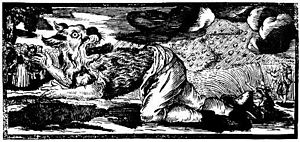
Thiess of Kaltenbrun, also spelled Thies, and commonly referred to as the Livonian werewolf, was a Livonian man who was put on trial for heresy in Jürgensburg, Swedish Livonia, in 1692. At the time in his eighties, Thiess openly proclaimed himself to be a werewolf (wahrwolff), claiming that he ventured into Hell with other werewolves in order to do battle with the Devil and his witches. Although claiming that as a werewolf he was a "hound of God", the judges deemed him guilty of trying to turn people away from Christianity, and he was sentenced to be both flogged and banished for life.
According to Thiess' account, he and the other werewolves transformed on three nights a year, and then traveled down to Hell. Once there, they fought with the Devil and his witches in order to rescue the grain and livestock which the witches had stolen from the Earth.
Various historians have turned their attention towards the case of Thiess, interpreting his werewolf beliefs in a variety of different ways. In his book The Night Battles (1966), the Italian historian Carlo Ginzburg compared Thiess' practices to those of the benandanti of northeastern Italy, and argued that they represented a survival of pre-Christian shamanic beliefs. Ginzburg's ideas were later critiqued by the Dutch historian Willem de Blécourt.